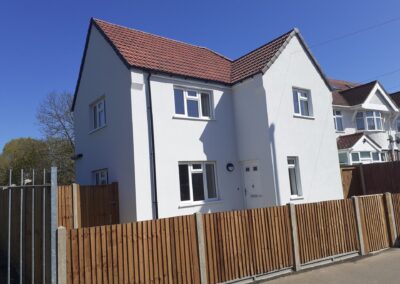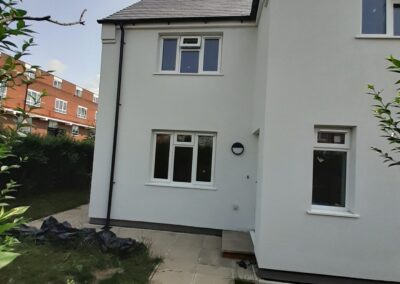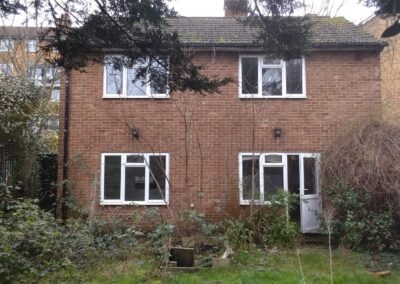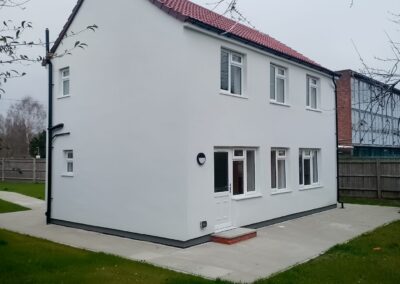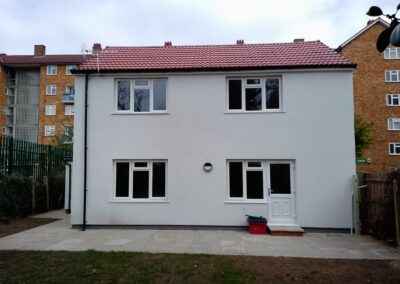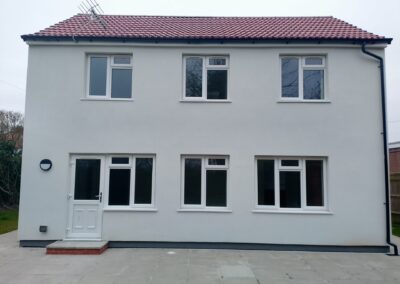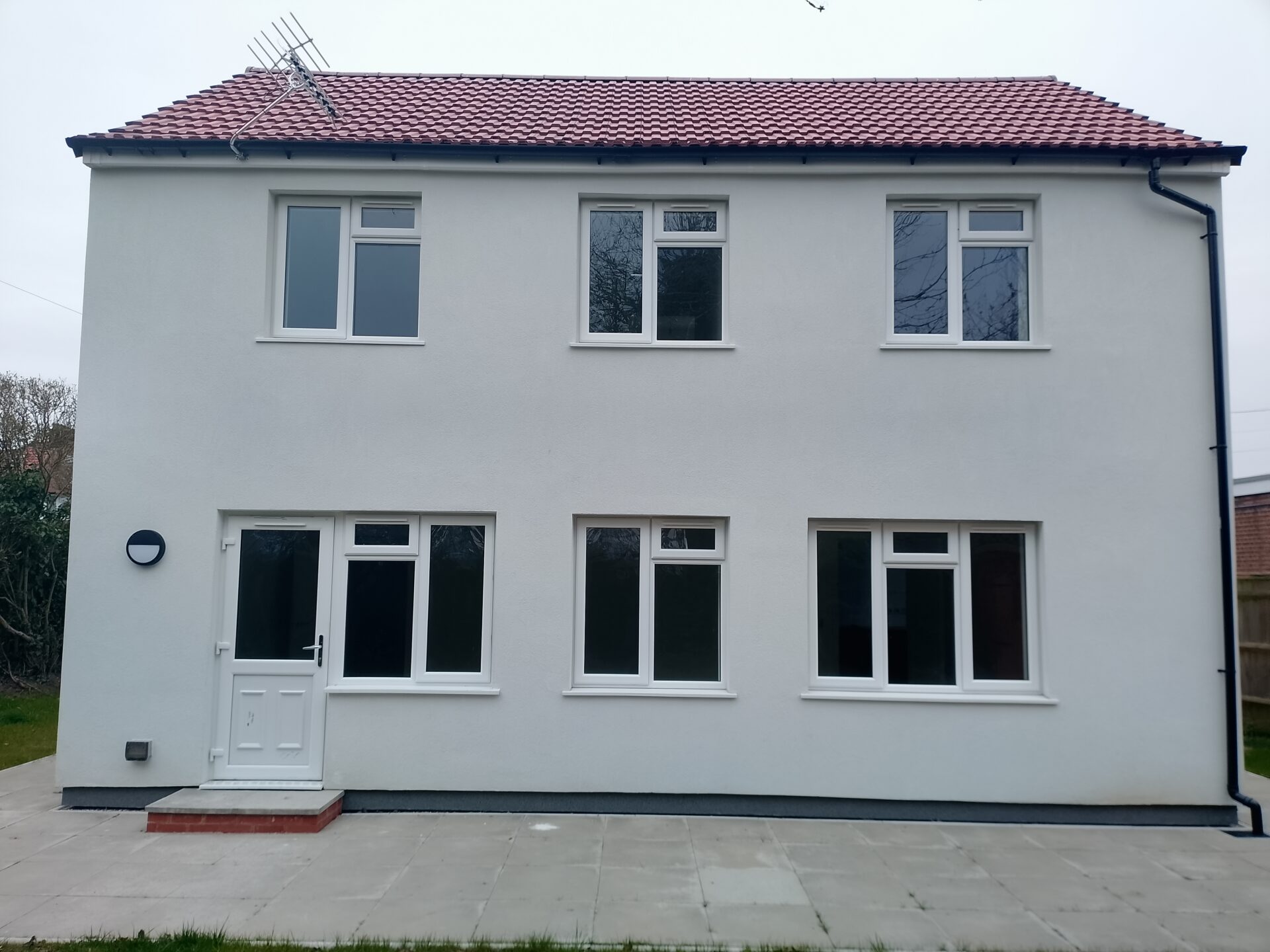INCA Case Study: Caretakers Homes London
Caretakers Homes London
Project Type: Refurbishment
Building Type: Low Rise, Residential
Architect: Welling Partnership LLC
System Designer: Soltherm
Installer: Mats Group Ltd
System & Finish: Soltherm Endurance W+ Silicone
U-Value Before: 0.30 W/m²K
U-Value After: 0.28 W/m²K
Project Overview
Six derelict caretaker dwellings dating from the 1930s–1950s—one two-bed semi-detached house at 250 Bedfont Lane and five three-bed detached houses scattered across Twickenham, Hounslow and Feltham—were stripped back to bare brick and re-imagined as contemporary, energy-efficient family homes using a Soltherm EWI systems expertly installed by Mats Group Ltd. Every roof covering, window, door and internal surface was removed, exposing the solid-wall fabric and revealing decades of neglect. Over the duration of the project, the houses evolved from vandalised shells to bright, comfortable dwellings, each with en-suite bedrooms and shared living-kitchen spaces. London Borough of Hounslow’s vision of returning forgotten assets to the housing stock now stands realised.
Client Objectives
- Transform redundant school housing into habitable, future-proof properties.
- Achieve high impact resistance and long-term durability to minimise maintenance.
- Improve thermal efficiency and cut future residents’ energy bills.
- Deliver works swiftly to meet acute local housing demand.
Unique Project Requirements
Hounslow specified a façade system capable of withstanding urban wear and tear while delivering measurable thermal gains. Soltherm Endurance W+—a silicone-finished, high-impact external wall insulation (EWI) system—was selected for its tested durability (>10 J impact resistance) and twenty-five-year life expectancy. Mineral-wool insulation offered non-combustibility (Euroclass A1), breathability and acoustic dampening—critical on busy suburban streets.
Technical Narrative
1. Fabric Recovery
Original lime-based plasters were entirely removed, exposing inconsistent brickwork and historic movement cracks. Masonry was stabilised using helibar stitching and polymer-modified repair mortars; this ensured a sound substrate for EWI dowel fixings and eliminated cold bridges at crack lines.
2. EWI Installation installed by Mats Group Ltd
- 110 mm dual-density mineral-wool slabs were adhesively bonded and mechanically fixed at 7.5 fixings/m², addressing uneven solid-wall planes up to ±15 mm.
- Alkali-resistant glass fibre reinforcement mesh was embedded within Soltherm high-flex polymer basecoat, achieving crack-span capacity >2.5 mm.
- Silicone topcoat in an off-white mineral texture provided vapour permeability, self-cleaning properties and UV stability.
3. Thermal Performance
Pre-works U-value modelling (BR 443) indicated 0.30 W/m²K. Post-installation calculation shows 0.28 W/m²K—significant for solid-wall stock where incremental gains translate directly into fuel-poverty reduction.
4. Roof and Fenestration
Complete re-roofing employed counter-battened breathable membranes and 0.18 W/m²K‐rated PIR insulation between trusses. New triple-glazed windows (1.0 W/m²K whole-window) and FD30 composite entrance doors integrated seamlessly with the EWI returns, eliminating reveal bridges.
5. Services Upgrade
A-rated boilers, MVHR units and LED lighting complement the improved envelope, maximising SAP scores and future-proofing OPEX for tenants.
Project Challenges and Resolutions
- Dereliction Risk: Asbestos-containing materials and rotten joists surfaced during strip-out. A rolling survey-and-remove protocol kept the programme intact without compromising safety.
- Multiple Sites, Single Programme: Simultaneous works across three borough zones demanded a hub-and-spoke logistics model; just-in-time deliveries and shared plant minimised traffic and carbon impacts.
- Heritage Fabric: Original handmade bricks were retained where structurally viable. EWI detailing preserved the proportions of sills and eaves, respecting the houses’ 1930s silhouettes.
Design, Location and Aesthetics
Traditional render harmonises with surrounding suburban facades yet offers a fresh, monolithic aesthetic absent from piecemeal patch repairs. Subtle ashlar lines echo the lost stretcher-bond pattern, while silicone texture refracts light, giving depth to formerly flat elevations. Re-landscaped frontages with permeable block paving and cycle storage complete the streetscape revival.
Added Value and Innovation
- High-Impact Façade: Soltherm’s double-mesh corner reinforcement and mineral-wool density gradient withstand daily knocks, reducing future maintenance spend.
- Rapid Thermal Win: A 0.02 W/m²K U-value drop appears modest but equates to ~£150 annual gas savings per dwelling (BREDEM-2012), crucial for low-income tenants.
- Social Re-activation: Six vacant plots now supply twenty-two en-suite rooms, easing pressure on the borough’s waiting list.
- Carbon Benefit: Embodied-carbon savings achieved by retaining primary masonry (~70 tCO₂e versus demolition) align with Hounslow’s climate emergency strategy.
Client Feedback
“Inspection at practical completion confirmed that each property surpasses our performance and aesthetic expectations. The meticulous façade work and internal fit-out have converted derelict liabilities into community assets ready for new families.” – London Borough of Hounslow Capital Projects Team
“Inspection at practical completion confirmed that each property surpasses our performance and aesthetic expectations. The meticulous façade work and internal fit-out have converted derelict liabilities into community assets ready for new families.”


